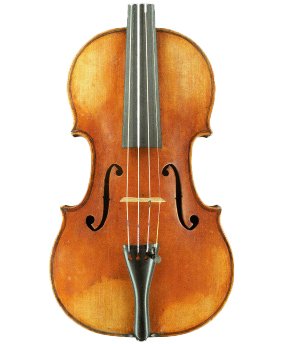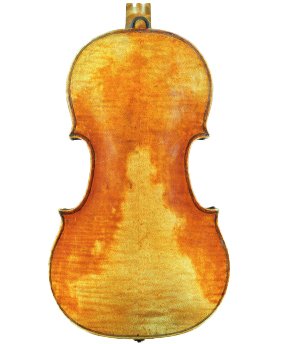


The marsh-bound city of Mantua was one of the glories of the Renaissance, but in the classical period of violin making, it generated only a small and well defined school of luthiers. Tomasso Balestrieri was one of the most prolific of the company, and his work is characteristic of the late eighteenth century in northern Italy in many interesting ways.
The instrument-making tradition of northern Italy owes a great deal to Isabella d'Este. Known as the first lady of the Renaissance, when she married Francesco Gonzaga in 1490 and became Duchess of Mantua, she was at the pinnacle of her influence. A great patron of the arts and music in particular, she did much to stimulate instrument making in the region. Even so, in the sixteenth century Mantua itself lacked violin makers of its own; it had a few lute makers and even a string maker from Rome, one Alessandro Taffelli, to keep the court orchestra supplied with the necessary gut, but violins themselves presumably came from nearby Cremona or Brescia. When Monteverdi gave the first performance of Orpheo there in 1607, there was already a full orchestra in residence at the Gonzaga court.
It was not until late in the seventeenth century that Mantua gained its first violin maker, recruited like Monteverdi, from Cremona. Pietro Guarneri was in fact hired as a violinist, receiving his court appointment in 1690. Nevertheless, he continued to make violins in the Cremonese style practiced by his father Andrea Guarneri, and in so doing passed this precious technique on to two generations of Mantuan luthiers.
Camillus Camilli appears to have been the most direct beneficiary of Guarneri's experience, and his beautifully made violins show distinctive Cremonese features, the problem being that he was only in his late teens when Guarneri died in 1720. An alternative history traces violin making in Mantua through the less well known Antonio Zanotti. He was born in the province of Lodi in about 1690, and made the claim on his labels to have been a pupil of Hieronymus Amati, which is not so unlikely as it sounds. Hieronymus II, the son of Nicolo Amati, left Cremona around 1700 and for a while worked in Piacenza, which is roughly halfway between Lodi and Cremona. Zanotti may have picked up the rudiments of the craft there. Zanotti's work seems to have more in common with Camilli than Amati, and the two worked in Mantua over a similar period, from about 1720 to 1750.
Camilli himself died in 1754, which is about the time that Tomasso Balestrieri's own labelled work becomes known. Whether or not he benefited from direct contact with Camilli is not known for sure, but it seems likely, and certain elements of Zanotti's style, as far as it can be isolated from Camilli, are also evident in Balestrieri's work. One key point is that Balestrieri, like Camilli and Guarneri, made use of the central register mark on the interior of the back seen in Amati instruments, which generally indicates that the maker was given instruction in the Cremonese method of working, in this case as passed on through Pietro Guarneri. During his most productive period, from around 1750 to 1780, Balestrieri was possibly the last working maker with direct knowledge of the original Cremonese technique and along with Michele Deconet in Venice, one of the last to make use of this distinctive interior layout marking. Only Nicola Bergonzi could make a significant claim to this illustrious heritage. Balestrieri actually claimed on his labels to be Cremonese himself, as did G.B.Guadagnini, but no proof of his origins in Cremona or Mantua has yet been found.
That said, Balestrieri represents a distantly evolved form of the Amati stock. In most other ways, his style reflects the more burly, powerful appearance of other makers of this post-classical period; aspects of Storioni, Guadagnini, even Carcassi rise to the surface in his instruments. This reflects the growing influence of Stradivari in the later eighteenth century and the gradual abandonment of Amati and Stainer models. Balestrieri's outline forms are strong and Stradivarian, although early examples do show a more feminine Amatese shape, shared by Pietro Guarneri, Camilli and Zanetto. He moved away from this pretty quickly, and seems to have been influenced by the last works of the Stradivari workshop in particular. His archings are fully rounded and powerful but not high, and the soundholes too are forceful, set broadly and prominently on the table. With small nicks and deeply fluted lower wings, the Fs are very reminiscent of late Stradivari work. His deficiency is in detail of craftsmanship, and of course in comparison to his earlier exemplars, in the varnish. While there are some Balestrieris with richly coloured red or orange coatings, they tend to be harder and chippier than the most lustrous Cremonese, and most are of a golden or darker brown hue. Guarneri's soft Cremonese varnish seems to have been the one thing that wasn't passed on to his followers.
Balestrieri used a broad purfling, set in a ruggedly cut, fairly deep trench around the borders. The corner mitres are fairly short, and the purfling itself rather ragged, the poplar core showing long splits produced by the action of the plane iron in cutting these thick veneers, and the black elements tending to fade to grey.
The most recognisable element of Balestrieri's work is the scroll, and it is interesting to relate it to his contemporaries. Like Storioni and others, including his Mantuan predecessor Zanotti, he tended to let the wide last turn of the volute wander far around the eye, as if unsure how to terminate it. The eye projects widely, and the whole scroll has a fairly cramped appearance. While the outline of the whole head has a very classical appearance, the original geometrical form of the Amati spiral which appears strongly in Camilli's work has been lost. The front face of the volute is typically cut right back, the central spine being depressed below the outer edges. Tool marks are strongly in evidence around the volute, but the pegbox is cleanly cut and very strongly shaped, with typically a rather short and confined throat.
Tomasso Balestrieri's instruments can be generally characterised as strong, powerful concert instruments with a full sound and forceful appearance. Drawn from a very deep well of Italian violin-making experience, they may not be the most refined of violins in craftsmanship, but rival the very best in performance.